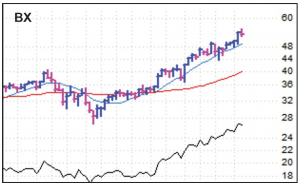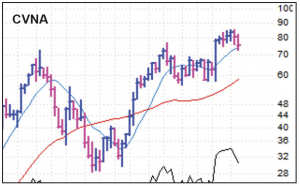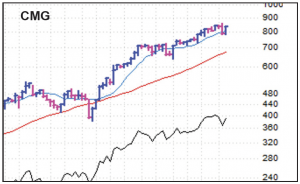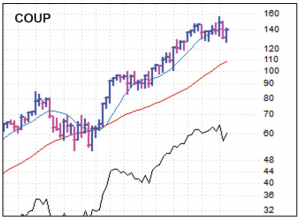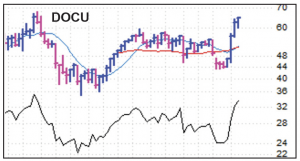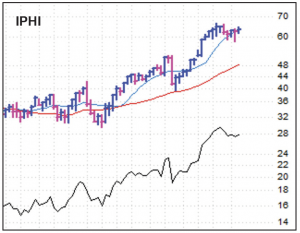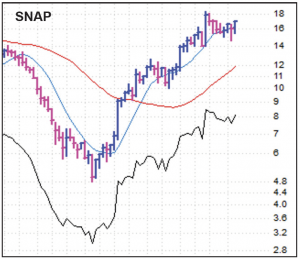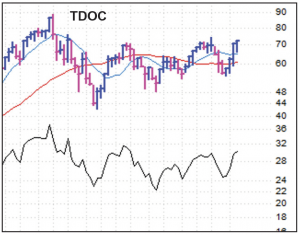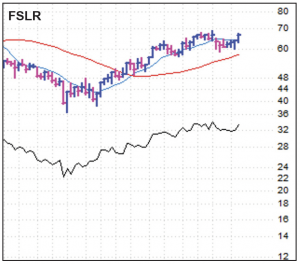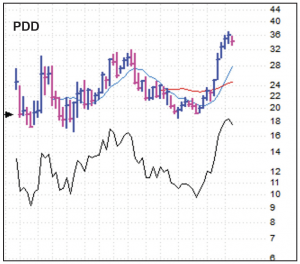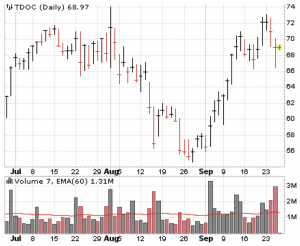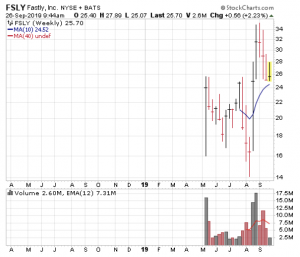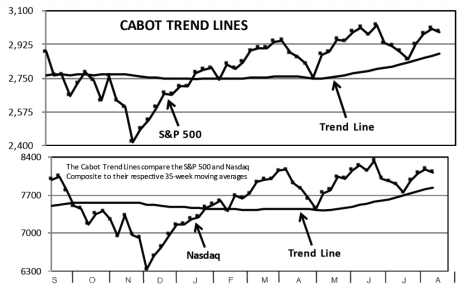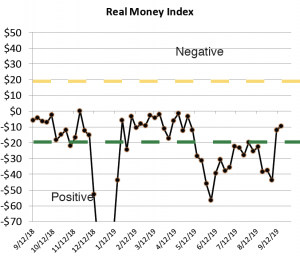The majority of the evidence when it comes to the overall market remains positive, but the environment for individual growth stocks remains very challenging—many are still holding up well, but no real money is being made as waves of selling pressures show up every couple of days. We’re still holding our resilient names and aren’t opposed to new buying here or there, but it’s important to hold some cash and keep new buys small until the bulls step up to the plate for more than a few hours at a time.
Cabot Growth Investor 1429
[premium_html_toc post_id="187344"]
Aggravation-to-Profit Ratio: High
Everybody loves a persistent uptrend in growth stocks, especially us; we know how to find the winners and ride them for the majority of their advance. That’s where the real money is! And while we don’t ever root for a big decline, we don’t get hot and bothered by a good-sized downturn, either—handling that environment isn’t much of a challenge, as sitting patiently in cash and building a watch list puts you in position to profit from the next uptrend.
However, in our experience, what can really do damage to your account (and your confidence) is the so-called meat grinder environment, which is effectively what we’re seeing now: Some stocks and sectors act well, but very few are making sustained upmoves, with sellers showing up every time they rally for a few days. (Indeed, the number of new highs on the Nasdaq yesterday was the second lowest daily reading during the past three months!) Throw in a bunch of news-driven moves (both for the market and individual stocks) and, if you’re not careful, you can get chewed up pretty quickly.
Said another way, the aggravation-to-profit ratio is very high right now—not a lot of profit, but plenty of aggravation. And that’s the main reason we’ve been stepping carefully, adding just a couple of half-sized positions this month and, coming into this week, holding more than a third of the portfolio in cash.
That said, we don’t want to sound too negative; the majority of evidence for the overall market (trends, secondary indicators, etc.) is still positive! Thus, it’s still a bull market, and we remain very optimistic that the next major move will be on the upside. Moreover, while many of this year’s leaders (those software and cybersecurity highfliers) continue to look done for, there are a good number of fresher names with solid growth stories in a variety of areas that look like they want to go higher—if the environment improves.
Thus, we’re not looking to turn defensive and aren’t predicting doom and gloom; the past few months of sloppy, news-driven action is probably setting the stage for the next sustained upmove. But it’s best to stay relatively close to shore until the market’s winds calm down.
[highlight_box]WHAT TO DO NOW: You should continue to stick with the game plan: Hold your strong and resilient stocks, and give your winners some room to breathe, but keep new buying on the small side and hold onto a chunk of cash. In the Model Portfolio, we added a half-sized position of Teladoc (TDOC) last week but tonight we’re selling our half position in Carvana (CVNA), which will leave us with a cash position of around 34%.
[/highlight_box]
Model Portfolio Update
Cabot’s founder, guru and all around great guy Carlton Lutts used to say that you can tell a lot about the market’s health just by looking at your own portfolio. And today, the stocks we own (and others we follow) remain hit or miss—few have enjoyed sustained buying pressures, and this week’s new batch of uncertainties has brought another round of selling.
That’s the main reason why, despite a Cabot Tides buy signal two weeks ago, we’ve been going very slow on the buy side, with just a couple of new half-sized positions; for every stock that’s in good shape, there’s another one that’s close to cracking. In fact, tonight, we’re letting go of our half position in CVNA as it’s violated our stop.
With most of the overall market’s evidence still positive, we’re not in a hurry to get defensive; in fact, we think a couple of good days could make a big difference, both for the market and growth stocks. But right now, the onus remains on the buyers to show up in a consistent way. In the meantime, we’re focused on babysitting weak stocks and honoring our stops.
Current Recommendations
BUY—Blackstone (BX 53)—After a few weeks of calm on the news front, Blackstone has been busy of late. It sold $1.2 billion of its position in Invitation Homes, is rumored to be hunting for an offer for
its 41% stake in Cheniere Energy Partners (worth nearly $10 billion!) and let it go of a $300 million position in NCR. Meanwhile, it spent $300 million to buy a piece of a South Korean shopping center, is in the bidding for a majority stake in Western Midstream and bought five Greek hotel businesses for $200 million or so. As for the stock, it’s been hit with a couple of valuation-related downgrades during the past two weeks, but BX is acting normally, consolidating on top of its 25-day line (now just above 51). Looking at the sell side, because our profit topped 20% early last week, we won’t let that decent gain morph into a loss if the market gets ugly—our mental stop is in the 46 to 47 area, a point or two above our cost basis. However BX is acting fine, and if you’re not yet in, we’re fine grabbing shares around here.
SELL—Carvana (CVNA 68)—We still think that, whenever growth stocks get their act together, CVNA could have a great run, as all the positive near- and long-term fundamentals we’ve written about are still in place. But we don’t own the story, we own the stock, and the selling pressures have been unrelenting of late, driving CVNA below its 50-day earlier this week and, today, below our stop in the upper 60s, which we intentionally left fairly loose to give shares plenty of room to wiggle. Obviously, it’s possible shares find support here and bounce, but it’s also possible that the weakness is growth stocks that began earlier this month continues, too. Long story short, we’ll keep an eye on CVNA in case it sets up in the weeks ahead, but the stock’s sharp decline of late has cracked its intermediate-term uptrend and will likely take time to repair—and that’s if buyers step in soon. We’re cutting the loss on our half-sized position tonight.
HOLD—Chipotle Mexican Grill (CMG 817)—We can’t say that CMG is out of the woods yet given the market, the stock’s big run and its sharp bout of distribution two weeks ago. But it’s handled itself about as well as can be expected in recent days, with five solid up days on above-average volume and, while it’s taken a hit with everything else this week, it’s etched a higher low (802 vs 780) during this selling wave. There’s no reason to think the underlying growth story has changed at all (in fact, analysts’ earnings estimates are still trickling higher), with new menu items and the continued spread of its digital business (including loyalty points and quick pick-up areas) attracting new customers. We sold one-third of our position two weeks ago, and are aiming to give our remaining stake room to breathe during this growth stock selloff. If you don’t own any, a nibble wouldn’t be the worst thing, but we’re sticking with our Hold rating, thinking the stock will probably need time (and a better environment) to make a lot of progress.
HOLD—Coupa Software (COUP 135)—Cloud software and cybersecurity stocks remain in the outhouse; Twilio, Workday and Okta, three stocks we owned during the year (and made solid money with), have all fallen around 30% from their highs, with each diving below their longer-term 200-day lines! Amidst this wreckage, COUP has been doing its best to hang in there, actually climbing to the 150 level earlier this week before retreating anew in recent days. The firm’s been quiet on the news front, and our thoughts haven’t changed—we still believe this stock can be a favorite of institutional investors if the software group can find its footing and the environment for growth stocks improves. But that’s a big if at this point, with the sector’s weakness dragging the stock back toward its August and September lows. We’ve already taken partial profits, and we’re OK giving the stock a bit more wiggle room; if you own some and have modest gains, we advise holding on. But we have a mental stop in the mid- to upper 120s for the rest of our position—a break of that would make the past three months look like a top.
BUY A HALF—DocuSign (DOCU 62)—DOCU has pulled in this week, but the chart looks fine; the 25-day line is obviously far away given the stock’s huge post-earnings run, but beyond that shares are holding the vast majority of their early-September gains. Overall, this still has the look of a new leader, with a powerful blastoff after some fundamental worries were cleared up (slowing billings growth in Q1 gave way to a 47% bump in billings in Q2). Obviously, the market is going to have a say in the stock’s intermediate-term future, but at this point DOCU’s dip looks normal—and buyable, at least for a small position. Encouragingly, even before the recent rally, the number of mutual funds owning shares totaled 579, more than double a year ago, and we’re betting those owners will be building positions going forward and even more will be coming onboard.
HOLD—Inphi (IPHI 62)—IPHI has had a wild week, with a nosedive on Monday (on no news) and follow-on selling on Tuesday before seeing some stabilization since. Meanwhile, all indications are that business continues to accelerate. One analyst said his research shows strong demand for Inphi’s data center systems from Google and Amazon, ramping shipments to telcos all over the world for its products that speed fiber optic transmissions and a solid outlook for the firm’s data interconnect products. And analysts still see sales up 20% both this year and next, with earnings rising 37% in 2020. Of course, good stories and business trends aren’t preventing stocks from getting hit; if IPHI drops to the 54 to 55 area, we’ll probably cut our loss on our half position. But we think the stock’s violent wiggles to this point are normal following the early-July breakout and run of 13 weeks up in a row. Long story short, we still have high hopes for Inphi and advise sitting tight.
BUY—ProShares Ultra S&P 500 Fund (SSO 129)—Taking a step back from the day-to-day headlines and action, it’s been a choppy past five months for the S&P 500 (and, hence, SSO), with a couple of sharp downs, some solid rallies, but net-net, the index is up around 1% during that time. Even so, coming on the heels of the huge January-April advance, and with the longer-term trend up, this still has the look of a normal (albeit frustrating) consolidation within an overall bull trend. Could the market fool us all and implode from here in the months ahead? Of course—anything is possible, and you shouldn’t rule anything out. But it’s always best to go with the odds, and with our Cabot Tides buy signal still in effect (not to mention the other positive timing indicators), the odds continue to favor higher prices down the road. We’ll stay on Buy.
HOLD—Snap (SNAP 17)—SNAP certainly has the feel of a stock that is ready to go up if the market can get out of its own way. Following a six-week pullback to a low of 14.5, the stock actually challenged its yearly highs this week before the market yanked it back down. Another analyst came out with positive commentary this week, saying usage of its app remains strong and long-term revenue potential should keep buyers interested. (Remember, Snap got $1.91 of revenue per user in Q2, which is less than one-fifth of what Facebook gets, and while Snap isn’t likely to approach that lofty level, even a doubling or tripling of this metric would be huge.) We’re not against nibbling here if you don’t own any, but as with most of our stocks, it’s unlikely a sustained upmove will start until the environment improves so we’ll stay on Hold.
BUY A HALF—Teladoc (TDOC 69)—Our timing on buying a half position in Teladoc couldn’t have been much worse (we entered last Friday) as (a) growth stocks have been hit hard and (b) Amazon announced it would offer its employees a virtual care service, which took a bite out of TDOC yesterday. However, while competition from Amazon is never a good thing, there’s probably less here than headlines suggest; one analyst actually thought the news could be a huge positive, since if Amazon decided to roll out a broader virtual care offering (to, say, its Prime members), it’s likely to partner with a firm that already has a virtual health provider network (like Teladoc) instead of building its own. Big investors apparently agree, with the stock’s pullback this week reasonable given the prior big-volume advance. (See page 7 for more on that.) We’re still OK buying a half-sized position here.
Watch List
Fastly (FSLY 24): Fastly is extremely wild, so we’d want to see it calm down before buying, but the story is potentially huge and the stock has shown some intriguing accumulation. See page 7.
Floor & Décor (FND 51): FND has broken out on the upside on solid volume this week, and if it can hold that move (most breakouts have quickly failed in recent weeks), we could take a swing at it.
MasTec (MTZ 65): MasTec remains immune to the growth stock maelstrom. Some further retrenchment could provide a solid entry point.
Novocure (NVCR 75): Maybe NVCR has topped for a while like many high-flying growth stocks, but there’s no harm in watching it; right now, NVCR is six weeks into a normal consolidation, though we’d like to see it find some buyers soon.
Pinduoduo (PDD 33): PDD has explosive growth, a unique story and a relatively strong chart. See page 6 for more.
Shake Shack (SHAK 98): We’re not sure we want to own two restaurant stocks, but we remain very impressed with Shake Shack’s fundamentals (rapid store expansion plan and improving same-store sales) and its chart (consolidating in the 95 to 105 level since the start of the month).
Other Stocks of Interest
The stocks below may not be followed in Cabot Growth Investor on a regular basis. They’re intended to present you with ideas for additional investment beyond the Model Portfolio. For our current ratings on these stocks, see Updates on Other Stocks of Interest on the subscriber website or email mike@cabotwealth.com.
Five Below (FIVE 128)—Five Below was a great winner for us during the past year, but we threw the last of our shares overboard in June as the stock tested long-term support—and it proceeded to plunge another 15% from there to new yearly lows! However, we never thought anything changed with the underlying story; its dollar stores have proven to be a hit with teen and pre-teen buyers looking for anything (sports gear, shirts, pool/beach supplies, candy, art supplies and more) up their alley, leading to amazing store economics (payback in less than one year!) and a rapid store expansion plan (20% or so per year). The issue, though, was tariffs and slowing mall foot traffic (one of the reasons same-store sales grew just 1.4% in the recent quarter); the results haven’t been impacted too much yet, but the uncertainty surrounding them has kept the stock under wraps. But management has made progress on mitigating the tariffs (including through modest price hikes), and the broad market’s recent strength has lifted FIVE back toward the top of its year-long range. It’s obviously going to be subject to wiggles based on the news and rumors of trade negotiations, but analysts see the firm’s bottom line rising around 20% next year, which is in line with Five Below’s longer-term growth plan. As for the stock, we can’t say it’s ready to get going yet; the trend is still sideways. But the action following its plunge toward the 100 level in August (five straight up weeks, including a bullish reaction to earnings, and a calm consolidation during the past two weeks) has been encouraging. We’re keeping a distant eye on FIVE to see if it can gather more strength and if business trends can stay on track.
First Solar (FSLR 63)—We haven’t been fans of solar stocks for a quite a while, as the sector’s trends have been very lumpy, and because investor perception changes rapidly, causing good-looking uptrends to go bad in a hurry. However, First Solar looks like it has the numbers and the story to enjoy a sustained advance. The company is one of the main players in the sector, and it’s been riding the ups and downs of the industry for years, but now it looks like the next couple of years at least are going to be boom times, partly due to the firm’s transition to its new Series 6 panels—they’re much larger than the prior iteration, and thanks to a big increase in manufacturing capacity, the firm is cutting the cost per watt dramatically. Perhaps more importantly in this up-and-down sector, First Solar has great visibility—it’s 98% sold out for the rest of this year, 95% sold out for 2020 and about 85% sold out for the first half of 2021, and it still sees big booking opportunities when looking further out. For what it’s worth, the stock also looks cheap, with management believing it will end this year with $1.8 billion of net cash (cash minus debt), compared to a market cap of just $7 billion. It’s not an amazing growth story, but we think the dependability and new Series 6 modules will attract big investors that have been scared away by the incessant on-again, off-again nature of the business. Like many stocks, FSLR is in the midst of a base-building effort, and last week’s oil spike helped the cause a bit. A breakout above 70 or so, especially with a push higher by the overall market, would be a good sign.
Pinduoduo (PDD 33)—If Chinese stocks really get going, we think many of the blue-chip names can do well; indeed, we wrote up Alibaba on this page of the last issue. But we always favor newer issues that have greater upside potential, and that’s why we have Pinduoduo on our watch list. On the surface, the firm looks like just another Chinese e-commerce play, but it has a very unique and differentiated offering: Pinduoduo offers a “social commerce” platform that encourages team shopping, as consumers are able to find solid bargains (much of what’s on the platform is off-season merchandise and the like), but are able to get even better prices if the products are purchased by a team, thus encouraging social interactions and inviting others to take part. The company does get a lot of business from super price-conscious shoppers in less populated areas, but about half of its orders come from those living in bigger cities, so the market is broad-based. And the new concept is catching on quick: Sales rose 169% in Q2, while gross merchandise volume lifted 171%, active buyers grew 41% (to a whopping 483 million) and spending per buyer leapt 92%. Sales and marketing costs here are sky high (84% of revenues!), which isn’t ideal, but they’re growing more slowly than revenues (up 105% in Q2) and other costs are minuscule—indeed, analysts see the firm’s bottom line reaching the black next year. As for the stock, it came public in July of last year, did nothing (net-net) through July but came alive after earnings in August, with the stock ripping to new peaks and pulling back over the past couple of weeks. We’d consider starting a position in PDD if the stock can handle itself well a bit longer.
Follow the Volume
When individual stocks go haywire like they have in recent weeks, it becomes harder to determine which stocks are true potential leaders and which ones are just getting yanked around by the crosscurrents. In these situations, there’s a good rule to keep in mind: Follow the volume.
Really, it’s always a good idea to look for outsized volume clues, which are the footprints of institutional investors. We’ve found that if a stock has a volume cluster (many days or weeks in a row of big volume) on the upside, pullbacks tend to be controlled (if they come at all) in the weeks ahead. And the flip side is true, too—repeated huge volume down days after a big advance implies that bounces are likely sellable in the near-term.
The reason is easy to understand: Big investors usually aren’t able to grab all the shares they want after accumulating for just a few days. Thus, pullbacks into the zone of the volume cluster usually brings support (or resistance).
Recent addition Teladoc (TDOC) is a good example. On the daily chart, look at how TDOC raced higher on eight straight days of above-average volume; despite some bad news on the competition front, the stock’s pullback has been reasonable this week, especially compared to the prior advance.
DocuSign (DOCU) is a classic example when examining a weekly chart. Since reporting earnings, its soared on three of its 4 heaviest volume weeks since coming public! In fact, this chart pattern is something we’ve labeled Double Skyscrapers (triple in DOCU’s case), as two massive-volume weekly advances out of a base usually precede big runs. (See chart on page 3.)
One other name that’s shown Double Skyscrapers that we’re keeping an eye on is Fastly (FSLY), which appears to be leading the way in a new networking industry—its “edge” cloud platform allows big clients (including New York Times, Ticketmaster, Spotify and a couple hundred other enterprises) deliver faster and better online experiences by moving a firm’s data, apps and logic (who can log in and see certain data) closer to the user. Even better, Fastly’s revenues are tied to usage, so it stands to benefit as clients increase their usage of its platform; in Q2, Fastly’s same-customer revenue surged 32%.
As for the stock, it’s a crazy-volatile recent IPO; we’d want to see it tighten up some before putting money to work. But, similar to DOCU, check out the two incredible volume weeks in August that saw FSLY zoom to new high. And while the pullback since then has been sharp (again, it’s volatile), it’s so far found support near the top of its IPO base. The story and volume clues make FSLY one to keep an eye on. WATCH.
Is the Two-Second Indicator (Finally) Speaking?
For many decades, one of our favorite measures of the broad market has been the number of stocks hitting new 52-week lows. The reason: Nearly all sustained market advances since 1960 saw very few stocks hitting new lows, whereas times when there were great divergences (large numbers of new lows while the indexes were going up) often preceded market corrections, including most major market tops.
Or, at least, that used to be the case. For whatever reason, during the past few years, the number of new lows regularly lifted above 40 on a daily basis (a threshold that had worked well for years) even during strong bull trends. 2017, for instance, was one of our best years of the past decade (Model Portfolio up 40%) and the market did well, too (S&P 500 up 20%), and yet the indicator flared up in March, May, June, August and November. 2018 ended badly, but the Two-Second Indicator was flashing red about 80% of the time even before the year-end slide, a time when many growth stocks enjoyed good runs. And it’s been a similar story with other solid years—2013 had a big red flag in August, just before the market took off on a big run, and stayed on-and-off negative for the rest of the year.
Thus, the sell signals that the indicator was built for have lost effectiveness. But most of the “all clear” signals—when new lows dry up in a big way—still do pretty well, even in the years just mentioned above. (New lows were very tame for the first four months of this year, coinciding with the market’s blastoff.)
That’s what has us intrigued today: The number of stocks hitting new lows on the NYSE has now come in at 40 or below for 16 straight trading days, a very strong sign that the relentless selling pressures on the broad market have ended.
We’re still going to take our cues from the market’s trends and the action of leading stocks, of course, But after years of on-again, off-again readings, the recent action is an encouraging sign that, with the selling pressure easing, the market could be setting up for a solid bull run go. We think it’s another arrow in the bulls’ quiver and will be something we’ll be keeping an eye on going forward.
Cabot Market Timing Indicators
The market itself remains in solid shape, with the trends still pointed up (despite this week’s dip) and some money finally beginning to come in off the sideline. But growth stocks remain on the outs, which tells us to go slow on the buy side and honor our stops.
Cabot Trend Lines: Bullish
The major indexes have been up and down since late April, but our Cabot Trend Lines continue to tell us the longer-term trend is pointed up, as both the S&P 500 (by 4.0%) and Nasdaq Composite (by 3.6%) closed clearly above their respective 35-week moving averages last Friday. Until proven otherwise, this is a bull market and the odds favor higher prices in the months ahead.
Cabot Tides: Bullish
Our Cabot Tides are holding their buy signal from two weeks ago, as all five major indexes (including the S&P 500, daily chart shown here) remain north of their lower (now 50-day) moving averages. Granted, there hasn’t been a ton of progress during the past few months and a drop of a couple of percent could nix the recent green light, so it’s still best to go slow on the buy side. But with the intermediate- and longer-term trends up, higher prices are more likely than not going forward.
Cabot Real Money Index: Neutral
Investors have finally begun to put some money to work, as our Real Money Index has popped into neutral territory. As with all sentiment measures, this indicator is secondary to the trends of the indexes and action of leading growth stocks. But after months of positive readings (tons of outflows), the inflows of the past two weeks are a sign that investor perception is beginning to improve.
[premium_html_footer]
Send questions or comments to mike@cabotwealth.com.
Cabot Growth Investor • 176 North Street, Post Office Box 2049, Salem, MA 01970 • www.cabotwealth.com
All Cabot Growth Investor’s buy and sell recommendations are made in issues or updates and posted on the Cabot subscribers’ website. Sell recommendations may also be sent to subscribers as special bulletins via email and the recorded telephone hotline. To calculate the performance of the portfolio, Cabot “buys” and “sells” at the midpoint of the high and low prices of the stock on the day following the recommendation. Cabot’s policy is to sell any stock that shows a loss of 20% in a bull market (15% in a bear market) from our original buy price, calculated using the current closing (not intra-day) price. Subscribers should apply loss limits based on their own personal purchase prices.
Charts show both the stock’s recent trading history and its relative performance (RP) line, which shows you how the stock is performing relative to the S&P 500, a broad-based index. In the ideal case, the stock and its RP line advance in unison. Both tools are key in determining whether to hold or sell.
THE NEXT CABOT GROWTH INVESTOR WILL BE PUBLISHED October 10, 2019
We appreciate your feedback on this issue. Follow the link below to complete our subscriber satisfaction survey: Go to: www.surveymonkey.com/marketlettersurvey
Neither Cabot Wealth Network nor our employees are compensated by the companies we recommend. Sources of information are believed to be reliable, but are in no way guaranteed to be complete or without error. Recommendations, opinions or suggestions are given with the understanding that subscribers acting on the information assume all risks. © Cabot Wealth Network. Copying and/or electronic transmission of this report is a violation of U.S. copyright law. For the protection of our subscribers, if copyright laws are violated, the subscription will be terminated. To subscribe or for information on our privacy policy, call 978-745-5532, visit www.cabotwealth.com or write to support@cabotwealth.com.
[/premium_html_footer]



